Cosmos SDK Transaction Lifecycle
In this article, we'll majorly talk about the transaction lifecycle and try to explain how the nodes create, transfer, validate and commit transactions in the Cosmos SDK based blockchain.
Blockchain Node Basic structure
First let's look at the basic structure of the Blockchain node. The cosmos-sdk-based blockchain node consists of two parts, one part is state-machine as an application layer, and the other part is Terndermint core which contains a consensus layer and a networking layer. While these two parts connect through the Application Blockchain Interface (ABCI).
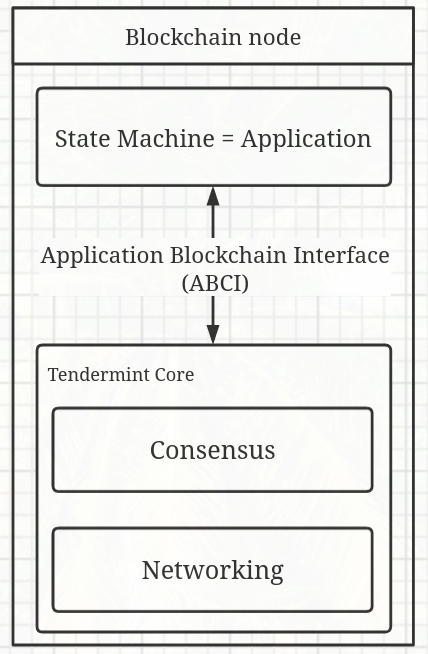
State-machine
A state machine is a machine that has multiple states, but only one
state at any given time. While transactions trigger the state
transitions. For example, by given a state S{.verbatim} and a
transaction T{.verbatim}, then the state machine returns a new state
S'{.verbatim} (S prime).

In practice, the transactions are bundled in blocks to make the process more efficient.

In a blockchain context, a note participates in the network, initializes its state machine, connects with other nodes and updates its state machine as new blocks come in.
So at its core, a blockchain is a replicated deterministic state machine. It means that if a node is started at a given state and replays the same sequence of transactions, it will always end up with the same final state.
Transaction
In Cosmos SDK-based blockchain each transaction contains different types of messages. Here is an example of a transaction with several messages.
{
body: {
messages: [
MsgSend,
MsgExec,
MsgExecuteContract,
/*...*/
],
memo: '100059323',
timeout_height: '0',
extension_options: [],
non_critical_extension_options: []
},
auth_info: {
signer_infos: [
{
public_key: {/*...*/},
mode_info: {/*...*/},
sequence: '6747'
},
],
fee: {
amount: [
{denom: 'uband', amount: '10000'},
],
gas_limit: '200000',
player: '',
granter: '',
},
},
signatures: [
'...'
]
}
And here is the content of Msg "MsgSend".
{
'@type': '/cosmos.bank.v1beta1.MsgSend',
from_address: 'address...',
to_address: 'to-address...',
amount: [
{
denom: 'uband',
amount: '6257900000',
}
]
}
State transition
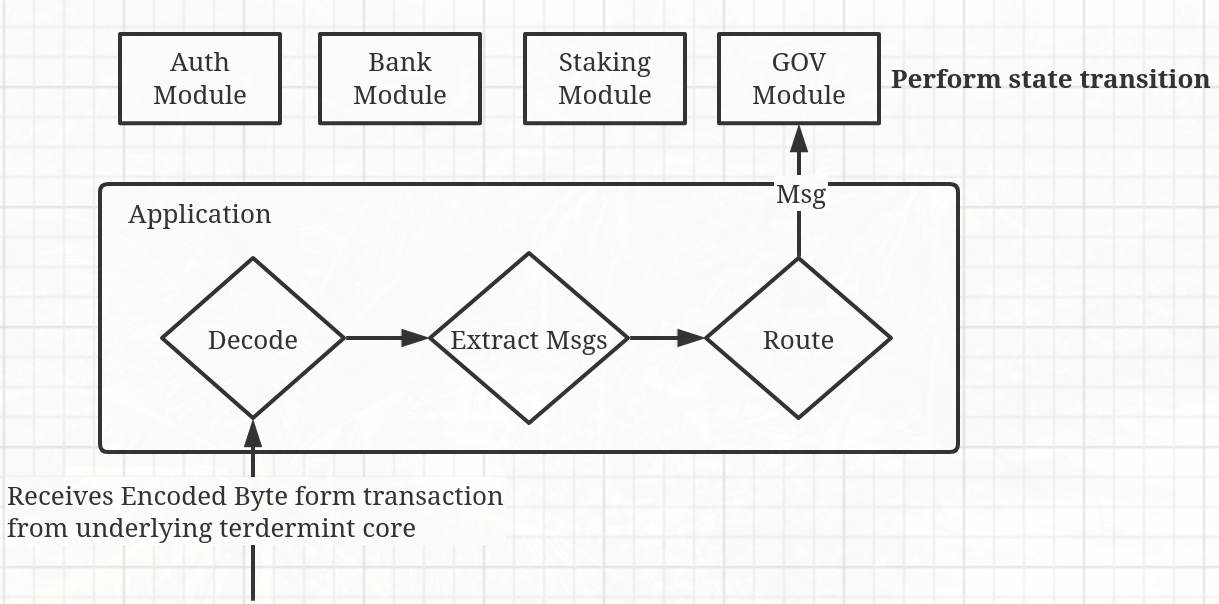
-
Decode
In blockchain node, the application (state manche) receives a transaction from the underlying tendermint core, the transaction is still in its encoded byte form and needs to be unmarshaled to be processed.
-
Extract Messages
After decoding, the application extracts messages from the transaction.
-
Route
The "Msg Service Router" routes each message to a differnt application module.
-
Perform a state transition
In the module, the "msgServer" handles the message to use a keeper to access the state store then perform the state transitions.
Tendermint Core

Tendermint Core performs Byzantine Fault Tolerant (BFT) State Machine Replication (SMR).
It means Tendermint is software for securely and consistently replicating an application (State-machine) on many nodes by transferring blocks of transactions.
- By "securely," means Tendermint works even if up to 1/3 of nodes fail in arbitrary ways.
- By "consistently," means that each non-faulty node sees the same transaction log and computes the same state.
Application Blockchain Interface
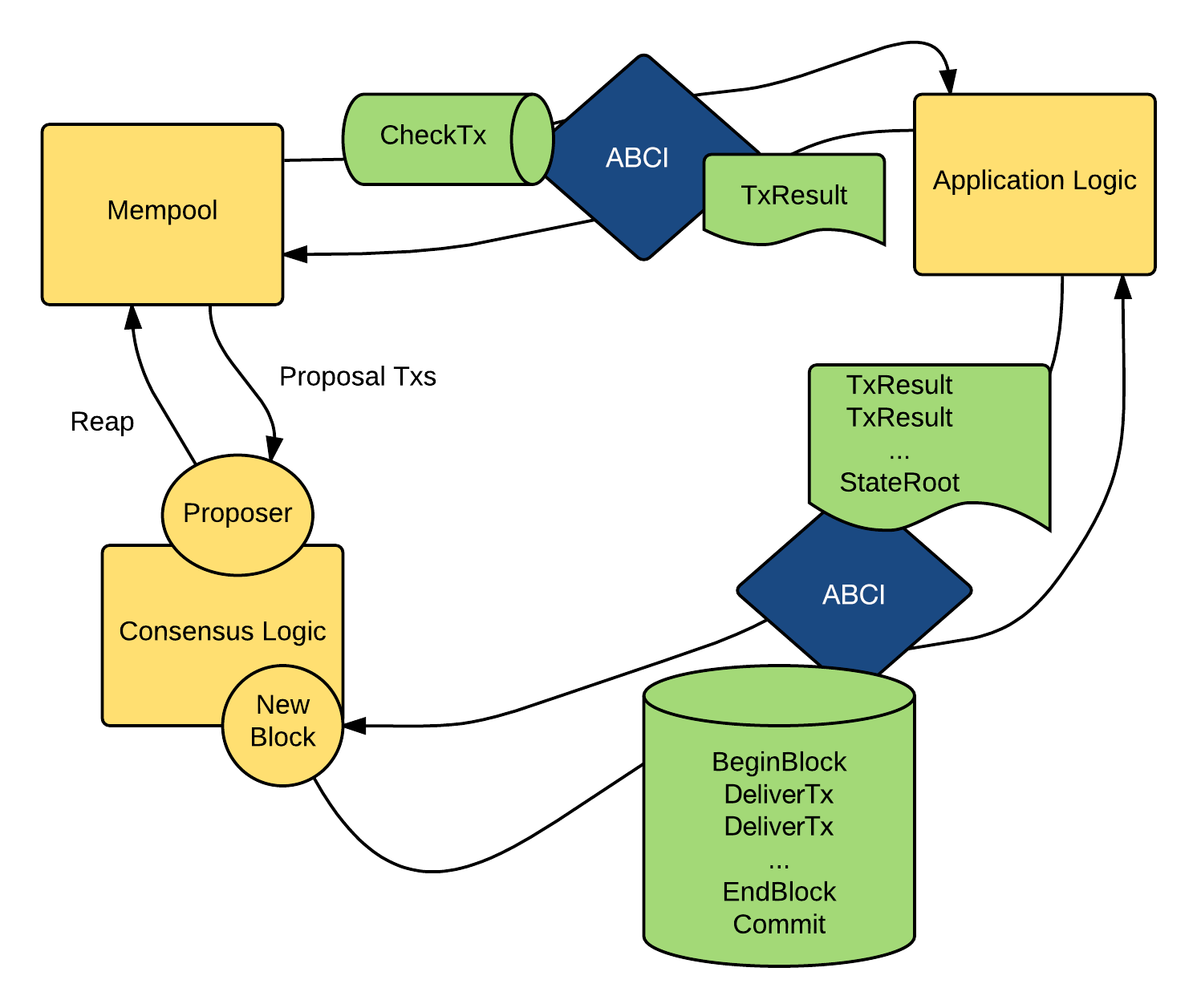
Application BlockChain Interface (ABCI) is the interface between Tendermint (a state-machine replication engine) and the application (the actual state machine) being replicated.
The Tendermint acts as a client to send requests and the application acts as a server to reply responses. The application needs to implement the API to be able to integrate with Tendermint. Through this way, we can build business modules in application layer without knowing the details about consensus layer and networking layer.
We can run the application in the same process as the Tendermint, or in a separate process.
When running the application in the same process, Tendermint call the APCI methods in the application directly as the regular Golang method calls.
When running the application in a separate process, Tendermint opens 4 connections to the application.
- Consensus connection
- Mempool connection
- Info connection
- Snapshot connection
The Consensus connection is driven by a consensus protocol and it's responsible for the block execution.
The node's "Mempool" is an in-memory pool of transactions that are candidates to be included in the next block. The Mempool connection is used for validating new transactions before sending them to Mempool.
The Info connection is responsible for initialization and queries from the users.
The Snapshot connection is responsible for serving and restoring state snapshots.
Here are the API method calls for each connection
- Consensus connection: InitChain, BeginBlock, DeliverTx, EndBlock, Commit
- Mempool connection: CheckTx
- Info connection: Info, Query
- Snapshot connection: ListSnapshots, LoadSnapshotChunk, OfferSnapshot, ApplySnapshotChunk
And there are two special method
- Flush method that is called on every connection
- Echo method that is just for debugging.
Additionally, in next generation of the Application Blockchain Interface (ABCI++), Tendermint has changed the most method calls for consensus connection
- Consensus connection: ListSnapshots, LoadSnapshotChunk, OfferSnapshot, ApplySnapshotChunk
Simplified Transaction lifecycle
At this point, let's look at the simplified transaction lifecycle.
- First, Nodes create transactions.
- Tendermit
- Broadcasts the new transactions to all the nodes
- Bundles the transations into blocks
- Transfers the blocks to all the nodes securely and consistently
- Involves Validators (some special nodes) to validate transactions and blocks durring broadcasting and transferring.
- At last, all the nodes commit the blocks of transactions to finalize the state change in the same way.
Application perspective
From the application perspective, the application performs operations includes
- Creating Transactions
- Validating Transactions
- Committing Transactions
Creating Transactions
Cosmos SDK provides 3 ways to create a transaction: command line, gRPC, or Rest interface.
Here is an example of using the command line to send a transaction to transfer 1000uatom from one address to another.
appd tx send <recipientAddress> 1000uatom \
--from <senderAddress> \
--gas auto \
--gas-adjustment 1.5 \
--gas-prices 0.025uatom
--gas{.verbatim}, refers to how much gas the current transaction consumes. Usually, it'll be set to "auto" to let the application automatically estimate the amount of gas.--gas-adjustment{.verbatim}, sometimes in practice, the real consumed gas is more than the estimated one, so the parameter--gas-adjustment{.verbatim} is used to scale the gas up to avoid underestimating.--gas-prices{.verbatim}, specifies how much the user is willing to pay per unit of gas. The validators will compare it with their local settingmin-gas-prices{.verbatim}, and they will reject transactions that "gas prices" are not high enough for the sake of anti-spam.
Validating Transactions
The node performs stateless checks, then stateful checks on the transaction to reject an invalid transaction as early as possible to avoid wasting computation.
Stateless checks
Stateless checks do not require nodes to access state and are thus less computationally expensive. Stateless checks include making sure addresses are not empty, enforcing nonnegative numbers, and other logic specified in the definitions.
Stateful checks
Stateful checks validate transactions and messages based on a committed state. Examples include checking that the relevant values exist and can be transacted with, the address has sufficient funds, and the sender is authorized or has the correct ownership to transact.
Validate one transaction
As mentioned previously, a node creates a new transaction and broadcast it to other nodes. After receiving this new transaction, all the other nodes need to validate it first before sending it to the "MemPool".
Validate one block of transactions
After bundling the transactions into blocks, the node needs to validate the transactions inside one block all together.
To fully validate one block, the node needs to execute all the transactions in it and perform the state transitions.
For example, one block contains two transactions. Both transactions withdraw cryptocurrency from the same account. One withdrawal is 100, the other withdrawal is 120, while the account balance is 200. The balance is sufficient for each of them separately, but not enough for total of them together.
Store Branching
The cosmos SDK maintain a main state and 2 primary volatile states. The main state is called "CommitMultiStore". The two volatile states, named "CheckState" and "DeliverState", are derived from the main state by using a mechanism called store branching.
During validation, the application only made changes in the volatile states.
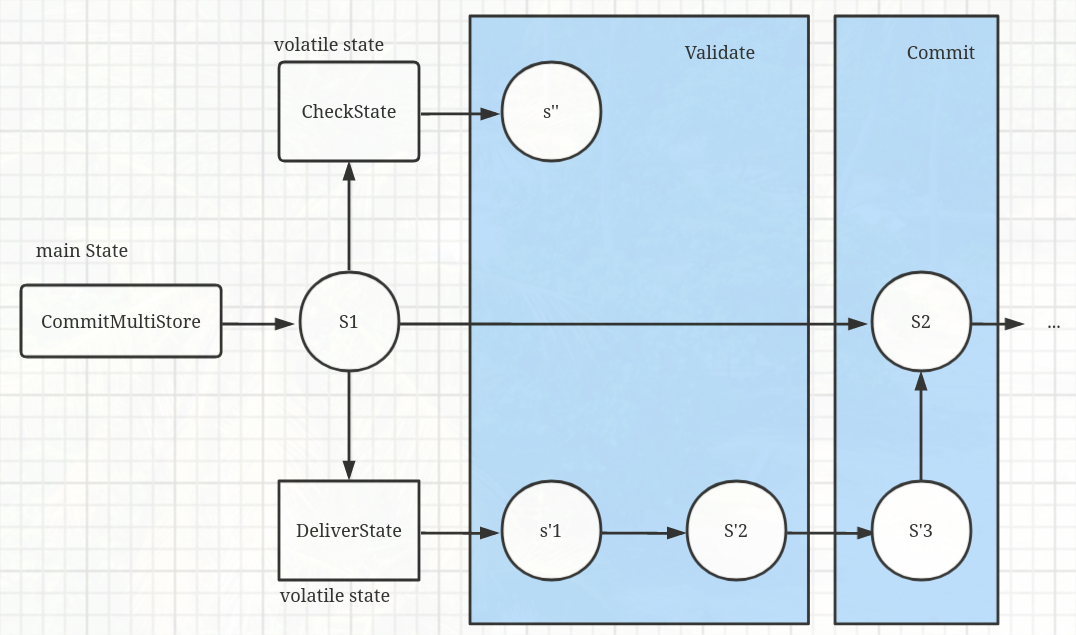
Commiting Transactions
The final step is for nodes to commit the block of transactions and finalize state changes.
During Commit all the state transitions that occurred in the volatile state are finally written to the mainn state "CommitMultiStore".
Tendermint Consensus
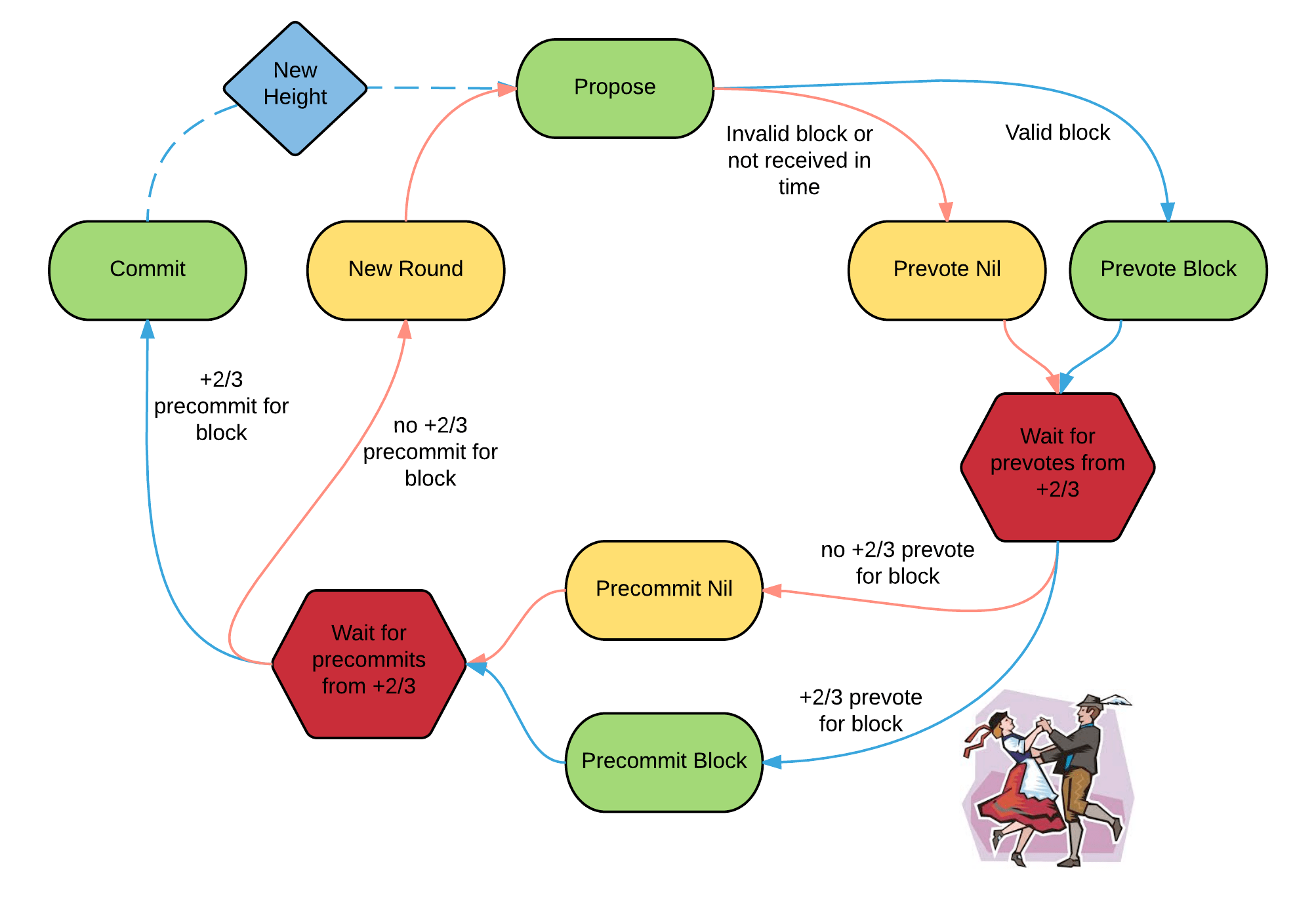
Consensus is all about transferring transactions securely and consistently. Tendermint consensus is the BFT(Byzantine fault tolerance) Consensus Algorithm.
After synchronizing with others to the same block height (H) of blockchain, a node will enter into a process of deciding the next block.
The process consists of several rounds (R) and two special steps (S).
- Each round contains 3 steps (S) Propose, Prevode, and Precommit.
- The two special steps are NewHeight and Commit Steps
NewHeight -> [rounds: (Propose->Prevote->Precommit) -> (Propose->Prevote->Precommit) -> …] -> Commit -> NewHeight -> …
In each round, the number of validators remains the same. Tendermint selects a proposer from the validators at the beginning.
The proposer collects a number of transactions from the "MemPool" with its own preference, bundles them into a block, and then sends the proposal of this new block to the other nodes.
The other validators receive the new block, validate all the transactions in it, then decide whether to send "prevote" for this new block to represent agree or disagree on the this proposal.
After sending "prevote", each validator keep listening for "prevote" from other validators. When the total number of "prevote"s is more the two thirds (2/3) of validators, the validator send "Precommit" for this new block, which means the validator tell the others that it found more 2/3 of validators agreed on the current proposal.
Meanwhile, all the nodes keep listening the "precommit" from validators. When the number of "precommit" is more than 2/3 of validators, which means 2/3 of validators conclude that they found 2/3 of validators agree on the current proposal, so at this point it's safe for the node to "Commit" the new block of transactions to finalize the state change, and then goto the step "NewHeight" to increase the block height of blockchain.
Sometimes, it may fail to commit the new block in one round. Maybe some of the step reach the timeout due to the network delay, or the Proposer suddenly went offline, or the proposal was from a malicious node, and so on.
So at this point, Tendermint needs to repeat the round several more times.
Proposer selection procedure
At its core, the proposer selection procedure uses a weighted round-robin algorithm. Let's quickly understand the algorithm through the simple pseudo-code.
def ProposerSelection (vset):
// compute priorities and elect proposer
for each validator i in vset:
A(i) += VP(i)
prop = max(A)
A(prop) -= p // p = VP(1) + VP(2) + ...
- "vset" is the validator set.
- "VP(i)" is the voting power of validator i.
- "A" is a priority queue "A(i)" is accumulated priority for validator i
- "P" is total voting power of set, P = VP(0) + VP(1) + VP(2) …
- "prop" is the proposer
At each round, the validator set remains the same, and each validator increases its priority by its voting power, and then the Tendermint selects the validator with the highest priority as proposer. After selecting, the proposer's priority will be decreased by P the total voting power of the set.
"A" is a priority queue. The validators move ahead in this queue according to their voting power (the higher the voting power the faster a validator moves towards the head of the queue).
Of cause, this only is a simplified version, in real code needs adjustment for adding and removing validators.
Summary
- At its core, blockchain is Replicated deterministic state machine
- Tendermint performs Byzantine Fault Tolerant (BFT) State Machine Replication (SMR)
- By implementing ABCI, developers can build business modules without knowing details about consensus and networking
- In Node, application performs creating, validating and committing transations.
- Tendermint consensus is BFT (Byzantine Fault Tolerance) Consensus Algorithm. It help nodes archive consensus on new block through the steps: NewHeight, Propose, Prevote, Precommit, and Commit.